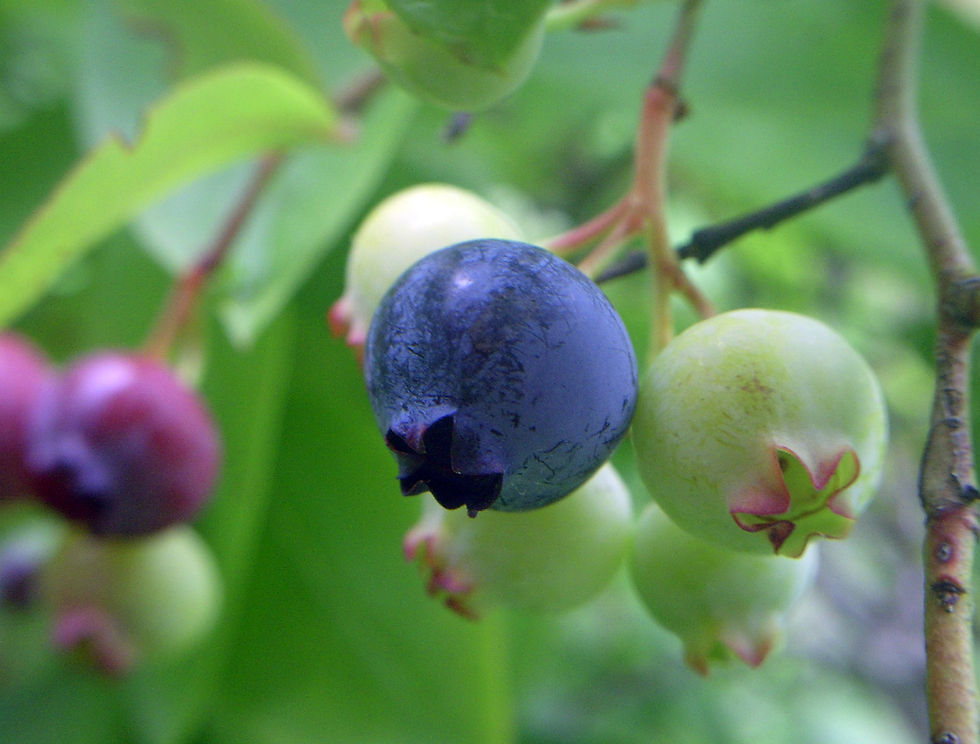The Laurels: Hardy and Beautiful
- Jennifer Anderson

- Apr 8, 2024
- 3 min read
Anyone remember Laurel and Hardy? Probably my grandparents’ generation. But when I think about the most beautiful of all native shrubs, the duo comes to mind, so I did a search on “Laurel,” thinking an episode might pop up.
Instead, I learned the definition of laurel is, in fact, the plant – although not our native laurels but a European variety in a family called Lauraceae. It also refers to a wreath of leaves the ancients wore on their heads.
Laurels native to New England are in Ericaceae, the Heath family, along with azaleas, blueberries and a few others, including Sourwood, Oxydendrum arboreum. Among other things, they all like slightly acidic soil.
Our Native Laurels
Among the native laurels, we carry Mountain Laurel (Kalmia latifolia) and Sheep Laurel (Kalmia angustifolia).
Year-Round Interest
Mountain Laurel is practically synonymous with beauty. Dark-pink spots (anthers) ring the inside of the light-pink, cup-like flowers that bloom profusely in late spring through mid-summer. The flowers are five-sided and appear at the tips of the branches, above the glossy, evergreen leaves.
New spring leaves emerge purplish before turning light green and finally dark and leathery through the winter. Mountain Laurel’s thick foliage and gnarled branches also provide year-round appeal.
Mountain Laurel can get up to 15 feet tall, even taller if trained to grow as a single-trunked tree. It grows naturally in dappled shade, in rocky woods or near tree lines, and in sandy soils and pine forests.
Tip #1: Pinching off dead flowers should result in a heartier bloom the following season and also a less-spindly plant.
Tip #2: Mulch around the roots will help retain moisture and mitigate stress from summer heat.
Kalmia angustifolia
Also beautiful, Sheep Laurel has its charm–and the immense benefit of being easier to keep alive.
Its preference is for full sun and moist, acidic soil, although it also grows in sand, on dry banks and in wet sites – particularly those that flood in spring and dry out in summer. In short, it grows in both well drained and poorly drained sites.
Sheep Laurel’s flowers look like its cousin’s in miniature and are a vibrant hot pink. They grow just below the newest foliage, so rather than frothy flowers riding on top of the plant they’re nestled among the leaves.
After the flowers come the tiny fruit capsules filled with winged seeds.
Size Matters
Much smaller than Mountain Laurel, Sheep Laurel tops out at 3 feet with a nearly 6-foot width, and it likes to form colonies. The leaves turn a deep reddish purple in winter and, like all laurels, are toxic to farm animals (hence the other common name, Lambkill). It does, however, provide important winter cover and food for birds.
Both laurels have high pollinator values (Mountain Laurel has a slight edge here) and Sheep Laurel also is a larval host to the Northern Blue Butterfly and Columbia Silkmoth.
Fun facts ☺:
#1 Mountain Laurel is the state flower of Pennsylvania and Connecticut, two states where it was once picked nearly to death in the wild.
#2 The wood of Mountain Laurel has been used to make tobacco pipes.
News and Notes
Hello Native Tree Lovers! We are still crossing our fingers for a May 1 opening! We will keep you posted.
Also, if you need even more inspiration to convert your yard to native plants, watch this handy video.
About the author:

Jennifer Anderson is the owner of Tree Talk Natives, a native tree and plant nursery in Rochester, Mass. She loves to talk native plants and can be reached at jennifer@treetalknatives.com.
Sources
Cullina, W. Native Trees, Shrubs & Vines 2002 Houghton Mifflin Co. Boston. Pages 150-152.
Jubela, J. Mountain Laurel. PennState Extension. July 5, 2023.
Kalmia angustifolia. Lady Bird Johnson Wildflower Center Plant Database.
Kalmia angustifolia. North Carolina Extension Gardener Plant Toolbox.
Kalmia latifolia. Lady Bird Johnson Wildflower Center Plant Database.
Kalmia latifolia. North Carolina Extension Gardener Plant Toolbox.
Kalmia angustifolia – sheep American-laurel, sheep-laurel. Native Plant Trust: Go Botany.
Rostaing, J. Mountain Laurel: A Shade-Tolerant Native With Beautiful Blossoms. Brooklyn Botanic Garden. June 3, 2016.
Shrubs of the Adirondacks: Sheep Laurel (Kalmia angustifolia). Adirondacks Forever Wild.













Comments